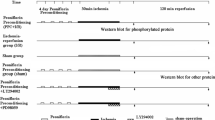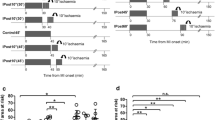Abstract
Ischemic postconditioning (IPC) represents one of the most effective cardioprotective strategies against myocardial ischemia/reperfusion. Depression is commonly present in patients with coronary heart disease. However, whether depression interferes with the cardioprotection of IPC during myocardial ischemia/reperfusion and their underlying mechanisms remain largely unknown. Isolated hearts from chronic mild stress induced-depressed rats and non-depressed rats were subjected to 30 min of regional ischemia followed by 120 min of reperfusion in the presence or absence of IPC (consisting of 6 cycles of 10 s of reperfusion and 10 s of ischemia immediately after the sustained ischemia). Myocardial infarct size, creatine kinase (CK) and cardiac troponin T (cTnT) release, cardiac function and phosphorylated AKT and signal transducer and activator of transcription-3 (STAT-3) were measured. IPC significantly prevented the hearts from myocardial ischemia/reperfusion injury by decreasing infarct size, and CK and cTnT release in coronary effluent, and improving cardiac functional recovery in non-depressed rats. However, these cardioprotective effects of IPC were not observed in depressed rats. In addition, IPC had no effects on the phosphorylation of AKT and STAT-3 at reperfusion in depressed hearts, although it markedly increased the phosphorylation of AKT and STAT-3 at reperfusion in non-depressed hearts. In conclusion, these data indicate that cardioprotection by IPC is abolished during myocardial ischemia/reperfusion in depressed rats, and the underlying mechanisms are probably related to the impaired activation of AKT and STAT-3 at reperfusion.





Similar content being viewed by others
References
Zhao ZQ, Corvera JS, Halkos ME, Kerendi F, Wang NP, Guyton RA, Vinten-Johansen J (2003) Inhibition of myocardial injury by ischemic postconditioning during reperfusion: comparison with ischemic preconditioning. Am J Physiol Heart Circ Physiol 285:H579–H588
Yellon DM, Hausenloy DJ (2003) Preconditioning the myocardium: from cellular physiology to clinical cardiology. Physiol Rev 83:1113–1151
Yellon DM, Hausenloy DJ (2005) Realizing the clinical potential of ischemic preconditioning and postconditioning. Nat Clin Pract 2:568–575
Hausenloy DJ, Yellon DM (2009) Preconditioning and postconditioning: underlying mechanisms and clinical application. Atherosclerosis 204:334–341
Yellon DM, Hausenloy DJ (2007) Myocardial reperfusion injury. N Engl J Med 357:1121–1135
Hausenloy DJ, Yellon DM (2006) Survival kinases in ischemic preconditioning and postconditioning. Cardiovasc Res 70:240–253
Tsang A, Hausenloy DJ, Mocanu MM, Yellon DM (2004) Postconditioning: a form of “modified reperfusion” protects the myocardium by activating the phosphatidylinositol 3-kinase-Akt pathway. Circ Res 95:230–232
Lacerda L, Somers S, Opie LH, Lecour S (2009) Ischaemic postconditioning protects against reperfusion injury via the SAFE pathway. Cardiovasc Res 84:201–208
Boengler K, Buechert A, Heinen Y, Roeskes C, Hilfiker-Kleiner D, Heusch G, Schulz R (2008) Cardioprotection by ischemic postconditioning is lost in aged and STAT3-deficient mice. Circ Res 102:131–135
Wagner C, Tillack D, Simonis G, Strasser RH, Weinbrenner C (2010) Ischemic post-conditioning reduces infarct size of the in vivo rat heart: role of PI3-K, mTOR, GSK-3beta, and apoptosis. Mol Cell Biochem 339:135–147
Heusch G, Boengler K, Schulz R (2008) Cardioprotection: nitric oxide, protein kinases, and mitochondria. Circulation 118:1915–1919
Boengler K, Hilfiker-Kleiner D, Drexler H, Heusch G, Schulz R (2008) The myocardial JAK/STAT pathway: from protection to failure. Pharmacol Ther 120:172–185
Skyschally A, Schulz R, Heusch G (2008) Pathophysiology of myocardial infarction: protection by ischemic pre- and postconditioning. Herz 33:88–100
Ovize M, Baxter GF, Di Lisa F, Ferdinandy P, Garcia-Dorado D, Hausenloy DJ, Heusch G, Vinten-Johansen J, Yellon DM, Schulz R (2010) Postconditioning and protection from reperfusion injury: where do we stand? Position paper from the Working Group of Cellular Biology of the Heart of the European Society of Cardiology. Cardiovasc Res 87:406–423
Hilfiker-Kleiner D, Hilfiker A, Fuchs M, Kaminski K, Schaefer A, Schieffer B, Hillmer A, Schmiedl A, Ding Z, Podewski E, Podewski E, Poli V, Schneider MD, Schulz R, Park JK, Wollert KC, Drexler H (2004) Signal transducer and activator of transcription 3 is required for myocardial capillary growth, control of interstitial matrix deposition, and heart protection from ischemic injury. Circ Res 95:187–195
Balakumar P, Rohilla A, Singh M, Anand-Srivastava MB (2008) Pre-conditioning and postconditioning to limit ischemia-reperfusion-induced myocardial injury: what could be the next footstep? Pharmacol Res 57:403–412
Ferdinandy P, Schulz R, Baxter GF (2007) Interaction of cardiovascular risk factors with myocardial ischemia/reperfusion injury, preconditioning, and postconditioning. Pharmacol Rev 59:418–458
Frasure-Smith N, Lesperance F (2010) Depression and cardiac risk: present status and future directions. Heart 96:173–176
Rozanski A, Blumenthal JA, Kaplan J (1999) Impact of psychological factors on the pathogenesis of cardiovascular disease and implications for therapy. Circulation 99:2192–2217
Lichtman JH, Bigger JT, Blumenthal JA, Frasure-Smith N, Kaufmann PG, Lesperance F, Mark DB, Sheps DS, Taylor CB, Froelicher ES (2008) Depression and coronary heart disease: recommendations for screening, referral, and treatment. Circulation 118:1768–1775
Willner P, Muscat R, Papp M (1992) Chronic mild stress-induced anhedonia: a realistic animal model of depression. Neurosci Biobehav Rev 16:525–534
Kocsis GF, Pipis J, Fekete V, Kovacs-Simon A, Odendaal L, Molnar E, Giricz Z, Janáky T, van Rooyen J, Csont T, Ferdinandy P (2008) Lovastatin interferes with the infarct size-limiting effect of ischemic preconditioning and postconditioning in rat hearts. Am J Physiol Heart Circ Physiol 294:H2406–H2409
Jang Y, Xi J, Wang H, Mueller RA, Norfleet EA, Xu Z (2008) Postconditioning prevents reperfusion injury by activating delta-opioid receptors. Anesthesiology 108:243–250
Papp M, Moryl E, Willner P (1996) Pharmacological validation of the chronic mild stress model of depression. Eur J Pharmacol 296:129–136
Grippo AJ, Johnson AK (2009) Stress, depression, and cardiovascular dysregulation: a review of neurobiological mechanisms and the integration of research from preclinical disease models. Stress 12:1–21
Willner P (1997) Validity, reliability and utility of the chronic mild stress model of depression: a 10-year review and evaluation. Psychopharmacology 134:1319–1329
World Health Organization (2008) The global burden of disease: 2004 update. World health Organization, Geneva
Thombs BD, Bass EB, Ford DE, Stewart KJ, Tsilidis KK, Patel U, Fauerbach JA, Bush DE, Ziegelstein RC (2006) Prevalence of depression in survivors of acute myocardial infarction. J Gen Intern Med 21:30–38
Musselman DL, Evans DL, Nemeroff CB (1998) The relationship of depression to cardiovascular disease: epidemiology, biology, and treatment. Arch Gen Psychiatry 55:580–592
Blazer DG, Kessler RC, McGonagle KA, Swartz MS (1994) The prevalence and distribution of major depression in a national community sample: the national co-morbidity survey. Am J Psychiatry 151:979–986
Hans M, Carney RM, Freedland KE, Skala J (1996) Depression in patients with coronary heart disease: a 12-month follow-up. Gen Hosp Psychiatry 18:61–65
Solskov L, Lofgren B, Pold R, Kristiansen SB, Nielsen TT, Overstreet DH, Schmitz O, Botker HE, Lund S, Wegener G (2010) Evaluation of the relationship between hyperinsulinaemia and myocardial ischaemia/reperfusion injury in a rat model of depression. Clin Sci (Lond) 118:259–267
Bouhidel O, Pons S, Souktani R, Zini R, Berdeaux A, Ghaleh B (2008) Myocardial ischemic postconditioning against ischemia-reperfusion is impaired in ob/ob mice. Am J Physiol Heart Circ Physiol 295:H1580–H1586
Tsang A, Hausenloy DJ, Mocanu MM, Carr RD, Yellon DM (2005) Preconditioning the diabetic heart: the importance of Akt phosphorylation. Diabetes 54:2360–2364
Butler KL, Huffman LC, Koch SE, Hahn HS, Gwathmey JK (2006) STAT-3 activation is necessary for ischemic preconditioning in hypertrophied myocardium. Am J Physiol Heart Circ Physiol 291:H797–H803
Yadav HN, Singh M, Sharma PL (2010) Involvement of GSK-3beta in attenuation of the cardioprotective effect of ischemic preconditioning in diabetic rat heart. Mol Cell Biochem. doi:10.1007/s11010-010-0500-z
Feng P, Guan Z, Yang X, Fang J (2003) Impairments of ERK signal transduction in the brain in a rat model of depression induced by neonatal exposure of clomipramine. Brain Res 991:195–205
Krishnan V, Han MH, Mazei-Robison M, Iniguez SD, Ables JL, Vialou V, Berton O, Ghose S, Covington HE 3rd, Wiley MD, Henderson RP, Neve RL, Eisch AJ, Tamminga CA, Russo SJ, Bolaños CA, Nestler EJ (2008) AKT signaling within the ventral tegmental area regulates cellular and behavioral responses to stressful stimuli. Biol Psychiatry 64:691–700
Coyle JT, Duman RS (2003) Finding the intracellular signaling pathways affected by mood disorder treatments. Neuron 38:157–160
Grippo AJ, Francis J, Beltz TG, Felder RB, Johnson AK (2005) Neuroendocrine and cytokine profile of chronic mild stress-induced anhedonia. Physiol Behav 84:697–706
Shelton RC (2007) The molecular neurobiology of depression. Psychiatr Clin North Am 30:1–11
Lee S, Chanoit G, McIntosh R, Zvara DA, Xu Z (2009) Molecular mechanism underlying Akt activation in zinc-induced cardioprotection. Am J Physiol Heart Circ Physiol 297:H569–H575
Ruan H, Li J, Ren S, Gao J, Li G, Kim R, Wu H, Wang Y (2009) Inducible and cardiac specific PTEN inactivation protects ischemia/reperfusion injury. J Mol Cell Cardiol 46:193–200
Xie P, Guo S, Fan Y, Zhang H, Gu D, Li H (2009) Atrogin-1/MAFbx enhances simulated ischemia/reperfusion-induced apoptosis in cardiomyocytes through degradation of MAPK phosphatase-1 and sustained JNK activation. J Biol Chem 284:5488–5496
Miyamoto S, Purcell NH, Smith JM, Gao T, Whittaker R, Huang K, Castillo R, Glembotski CC, Sussman MA, Newton AC, Heller Brown J (2010) PHLPP-1 negatively regulates Akt activity and survival in the heart. Circ Res. doi:10.1161/CIRCRESAHA.109.215020
Keyes KT, Xu J, Long B, Zhang C, Hu Z, Ye Y (2010) Pharmacological inhibition of PTEN limits myocardial infarct size and improves left ventricular function postinfarction. Am J Physiol Heart Circ Physiol 298:H1198–H1208
Przyklenk K, Maynard M, Darling CE, Whittaker P (2008) Aging mouse hearts are refractory to infarct size reduction with post-conditioning. J Am Coll Cardiol 51:1393–1398
Lin YH, Liu AH, Xu Y, Tie L, Yu HM, Li XJ (2005) Effect of chronic unpredictable mild stress on brain-pancreas relative protein in rat brain and pancreas. Behav Brain Res 165:63–71
Lu R, Hu CP, Peng J, Deng HW, Li YJ (2001) Role of calcitonin gene-related peptide in ischemic preconditioning in diabetic hearts. Clin Exp Pharmacol Physiol 28:392–396
Acknowledgment
This study was supported by the Foundation from Science and Technology Commission of Dongli District, Tianjin City (No. ANSF200801).
Author information
Authors and Affiliations
Corresponding author
Additional information
Chuanjun Zhuo and Ying Wang contributed equally to this work.
Rights and permissions
About this article
Cite this article
Zhuo, C., Wang, Y., Wang, X. et al. Cardioprotection by ischemic postconditioning is abolished in depressed rats: role of Akt and signal transducer and activator of transcription-3. Mol Cell Biochem 346, 39–47 (2011). https://doi.org/10.1007/s11010-010-0589-0
Received:
Accepted:
Published:
Issue Date:
DOI: https://doi.org/10.1007/s11010-010-0589-0




